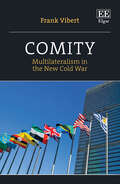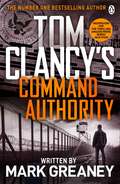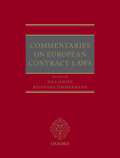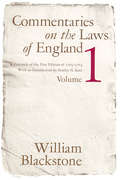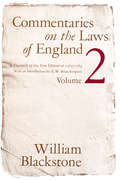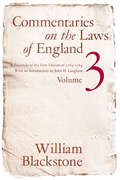- Table View
- List View
Combatting Disruptive Change: Beating Unruly Competition at Their Own Game
by Ian I. MitroffThis book is a critical examination of the main ideas regarding disruptive change and startups. It systematically lays out the full set of challenges and tasks one needs to master in order for existing organizations to weather severe change or make a startup successful. Ian Mitroff outlines the protective actions business leaders must take to ensure their continued existence, providing a clear demonstration of the key roles leaders must assume such as Applied Epistemologist, Applied Ethicist, Applied Systems Thinker, Applied Social Psychologist, and Applied Crisis Manager, and how to perform these roles competently.Citing cases such as Facebook, Uber, and Airbnb, this book uniquely analyzes the disrupting agent in emerging industries, which is crucial for success in today’s complex and turbulent world. It will be of value to students, academics, and entrepreneurs looking to develop a new product or service.
Combatting Illicit Trade in Tobacco Products: In Search of Optimal Enforcement
by Stanisław Tosza John A. E. VervaeleThis book focuses on the enforcement aspect of tobacco control policy, and argues that the intense regulation of the tobacco market will never be successful as long as it can be circumvented by the availability of illicit tobacco products. Yet, current efforts to combat illicit tobacco trade are insufficient, suffering from several flaws and gaps at the regulatory and operational levels. The aim of this book is to provide an analysis of the legal framework and practice of enforcement with regard to illicit tobacco products. Combining criminological and legal perspectives, it presents and critically analyses the phenomenon of illicit tobacco trade, as well as the policies, legal frameworks and practices in six EU countries with regard to combatting this phenomenon, assessing the strengths and weaknesses of their approaches. Furthermore, it studies the relationship between the EU and third countries (e.g. Ukraine) in terms of how the EU can influence policy and enforcement in these countries in order to counter illicit tobacco trafficking. Not exclusively focusing on the EU, the book also includes an analysis of enforcement against illicit tobacco products in the US. The EU Member States analysed in the book (Belgium, Germany, Italy, Latvia, the Netherlands and Poland) reflect the range of currently available approaches. Some of them have ratified the WHO Protocol against tobacco smuggling; others have not. They belong to different legal traditions and face different challenges due to their respective border situations. While Belgium and the Netherlands are key entry ports to the EU, Poland and Latvia represent the Eastern land border of the EU, with various regional challenges. Italy has a long maritime border, where trafficking is possible from Northern Africa and from the Middle East. It also has significant experience in fighting organised crime. Lastly, Germany is the largest market in Europe and situated in the middle of these trafficking routes.
Combatting Illicit Trade on the EU Border: A Comparative Perspective
by Celina NowakThis open access book provides the first-ever comparative study on criminal policy concerning the illicit trade of tobacco, conducted among four comparatively new EU Member States (Lithuania, Poland, Slovakia and Romania) and two “old” EU countries (Germany and Italy). The book addresses the national legal frameworks, current criminological situation regarding illicit trade of tobacco, and the practical challenges faced by national law enforcement authorities in the countries examined. It also considers the international framework, and concludes with a horizontal report. The objective of the book is to highlight legislative and practical challenges in the fight against illegal tobacco products at the national and transnational level, and to formulate recommendations for overcoming them more effectively in Europe.
Combined Transport Documents: A Handbook of Contracts for the Combined Transport Industry
by John RichardsonCombined Transport Documents provides a comprehensive guide to combined transport or multi-modal contracts. It examines the main contracts that deal with combined transport logically, from those concerned with the procuring of tonnage through to those that deal with general average and salvage. It also focuses on the complicated chains of indemnity particular to multimember consortium operations and explains in substantial detail a recommended draft bill of lading contract of carriage which the author himself developed. Combined Transport Documents provides a comprehensive guide to combined transport or multi-modal contracts. It examines the main contracts that deal with combined transport logically, from those concerned with the procuring of tonnage through to those that deal with general average and salvage. It also focuses on the complicated chains of indemnity particular to multi-member consortium operations and explains in substantial detail a recommended draft bill of lading contract of carriage which the author himself developed.
Combined Transport Documents: A Handbook of Contracts for the Combined Transport Industry
by John RichardsonCombined Transport Documents provides a comprehensive guide to combined transport or multi-modal contracts. It examines the main contracts that deal with combined transport logically, from those concerned with the procuring of tonnage through to those that deal with general average and salvage. It also focuses on the complicated chains of indemnity particular to multimember consortium operations and explains in substantial detail a recommended draft bill of lading contract of carriage which the author himself developed. Combined Transport Documents provides a comprehensive guide to combined transport or multi-modal contracts. It examines the main contracts that deal with combined transport logically, from those concerned with the procuring of tonnage through to those that deal with general average and salvage. It also focuses on the complicated chains of indemnity particular to multi-member consortium operations and explains in substantial detail a recommended draft bill of lading contract of carriage which the author himself developed.
Combining Mediation and Arbitration in International Commercial Dispute Resolution (Routledge Research in International Commercial Law)
by Dilyara NigmatullinaSecuring fast, inexpensive, and enforceable redress is vital for the development of international commerce. In a changing international commercial dispute resolution landscape, the combined use of mediation and arbitration has emerged as a dispute resolution approach which offers these benefits. However, to date there has been little agreement on several aspects of the combined use of processes, which the literature often explains by reference to the practitioner’s legal culture, and there is debate as to how appropriate it is for the same neutral to conduct both mediation and arbitration. Identifying the main ways of addressing concerns associated with the same neutral conducting both mediation and arbitration (same neutral (arb)-med-arb), this book examines how effectively these methods achieve the goal of fast, inexpensive, and enforceable dispute resolution, evaluating to what extent the perception and use of the same neutral (arb)-med-arb depends on the practitioner’s legal culture, arguing that this is not a ‘one-size-fits-all’ process. Presenting an empirical study of the combined use of mediation and arbitration in international commercial dispute resolution, this book synthesises existing ways of addressing concerns associated with the same neutral (arb)-med-arb to provide recommendations on how to enhance the use of combinations in the future.
Combining Mediation and Arbitration in International Commercial Dispute Resolution (Routledge Research in International Commercial Law)
by Dilyara NigmatullinaSecuring fast, inexpensive, and enforceable redress is vital for the development of international commerce. In a changing international commercial dispute resolution landscape, the combined use of mediation and arbitration has emerged as a dispute resolution approach which offers these benefits. However, to date there has been little agreement on several aspects of the combined use of processes, which the literature often explains by reference to the practitioner’s legal culture, and there is debate as to how appropriate it is for the same neutral to conduct both mediation and arbitration. Identifying the main ways of addressing concerns associated with the same neutral conducting both mediation and arbitration (same neutral (arb)-med-arb), this book examines how effectively these methods achieve the goal of fast, inexpensive, and enforceable dispute resolution, evaluating to what extent the perception and use of the same neutral (arb)-med-arb depends on the practitioner’s legal culture, arguing that this is not a ‘one-size-fits-all’ process. Presenting an empirical study of the combined use of mediation and arbitration in international commercial dispute resolution, this book synthesises existing ways of addressing concerns associated with the same neutral (arb)-med-arb to provide recommendations on how to enhance the use of combinations in the future.
Come to This Court and Cry: How the Holocaust Ends
by Linda Kinstler'Part detective story, part family history, part probing inquiry into how best to reckon with the horrors of a previous century, Come to This Court and Cry is bracingly original, beautifully written and haunting. An astonishing book' Patrick Radden Keefe, author of Empire of Pain'Kinstler reminds us of the dangerous instability of truth and testimony, and the urgent need, in the twenty-first century, to keep telling the history of the twentieth' Anne Applebaum'A masterpiece' Peter PomerantsevTo probe the past is to submit the memory of one's ancestors to a certain kind of trial. In this case, the trial came to me.A few years ago Linda Kinstler discovered that a man fifty years dead – a former Nazi who belonged to the same killing unit as her grandfather – was the subject of an ongoing criminal investigation in Latvia. The proceedings threatened to pardon his crimes. They put on the line hard-won facts about the Holocaust at the precise moment that the last living survivors – the last legal witnesses – were dying.Across the world, Second World War-era cases are winding their way through the courts. Survivors have been telling their stories for the better part of a century, and still judges ask for proof. Where do these stories end? What responsibilities attend their transmission, so many generations on? How many ghosts need to be put on trial for us to consider the crime scene of history closed?In this major non-fiction debut, Linda Kinstler investigates both her family story and the archives of ten nations to examine what it takes to prove history in our uncertain century. Probing and profound, Come to this Court and Cry is about the nature of memory and justice when revisionism, ultra-nationalism and denialism make it feel like history is slipping out from under our feet. It asks how the stories we tell about ourselves, our families and our nations are passed down, how we alter them, and what they demand of us.
Come to This Court and Cry: How the Holocaust Ends
by Linda Kinstler'Part detective story, part family history, part probing inquiry into how best to reckon with the horrors of a previous century, Come to This Court and Cry is bracingly original, beautifully written and haunting. An astonishing book' Patrick Radden Keefe, author of Empire of Pain'Kinstler reminds us of the dangerous instability of truth and testimony, and the urgent need, in the twenty-first century, to keep telling the history of the twentieth' Anne Applebaum'A masterpiece' Peter PomerantsevTo probe the past is to submit the memory of one's ancestors to a certain kind of trial. In this case, the trial came to me.A few years ago Linda Kinstler discovered that a man fifty years dead – a former Nazi who belonged to the same killing unit as her grandfather – was the subject of an ongoing criminal investigation in Latvia. The proceedings threatened to pardon his crimes. They put on the line hard-won facts about the Holocaust at the precise moment that the last living survivors – the last legal witnesses – were dying.Across the world, Second World War-era cases are winding their way through the courts. Survivors have been telling their stories for the better part of a century, and still judges ask for proof. Where do these stories end? What responsibilities attend their transmission, so many generations on? How many ghosts need to be put on trial for us to consider the crime scene of history closed?In this major non-fiction debut, Linda Kinstler investigates both her family story and the archives of ten nations to examine what it takes to prove history in our uncertain century. Probing and profound, Come to this Court and Cry is about the nature of memory and justice when revisionism, ultra-nationalism and denialism make it feel like history is slipping out from under our feet. It asks how the stories we tell about ourselves, our families and our nations are passed down, how we alter them, and what they demand of us.
Comic Art, Creativity and the Law (Elgar Law and Entrepreneurship series)
by Marc H. GreenbergGraphic novels and comics have launched characters and stories that play a dominant role in contemporary popular culture throughout the world. The extensive revisions in this second edition of Comic Art, Creativity and the Law update the author’s analysis of important changes at the intersection of law and comics, featuring an examination of how recent cases will affect the creative process as applied to comic art.Throughout, Marc H. Greenberg examines the impact of contract law, copyright law (including termination rights, parody and ownership of characters), tax law and obscenity law on the creative process. He considers how these laws enhance and constrain the process of creating comic art by examining the effect their often inconsistent and incoherent application has had on the lives of creators, retailers and readers of comic art. Thoroughly revised and updated, there are new chapters featuring a discussion of important new cases in copyright work-for-hire and fair use doctrines; the intersection of law and fan-based creations, such as fan fiction, fan art, fan film and cosplay; as well as a new chapter on licensing comics for motion pictures and television.Designed for academics, practitioners, students of law and fans of comic art, the book offers proposals for changes in those laws that constrain the creative process, as well as a glimpse into the future of comic art and the law.
Comics and Conquest: Political Cartoons And A Radical Retelling Of The Navajo-hopi Land Dispute
by Rhiannon KoehlerComing-of-Age Cinema in New Zealand: Genre, Gender and Adaptation in a National Cinema (Traditions In World Cinema Ser.)
by Alistair FoxExplores the complex ethical dilemmas of human mobility in the context of climate change
Coming-of-Age Cinema in New Zealand: Genre, Gender and Adaptation in a National Cinema
by Alistair FoxNew scholarly essays on the short story in English as a phenomenon of world literature
Comity: Multilateralism in the New Cold War
by Frank VibertThis timely book explores a critical new juncture where globalisation is in retreat and global norms of behaviour are not converging. Frank Vibert provides an expert analysis on how this situation has arisen from a combination of changes in the relative power and position of nations and the different values behind the organisation of domestic government in democracies and authoritarian states.Vibert challenges the assumption that differences in the way countries organise their domestic form of government can be kept separate from rulemaking at the international level. The book examines how democracies can defend their own values relative to others, the methods of influence, and the ways of managing conflict between contending values. Comity maps a path away from impasse to where democracies cooperate to make rules for themselves that can then be extended to others. It also discusses the legitimacy of this form of international rulemaking. Vibert concludes with the need for democracies to address their own democratic backsliding and to refresh their alliances with other democracies.This book steps back from conventional claims that we are heading towards an ever more globalised world and sets out the importance of norms in shaping institutions, relationships and the techniques of rulemaking. The book will be critical reading for scholars of international relations, constitutional and administrative law, regulation, and international politics. It will also be useful for practitioners in international organisations, governments and administrative bodies.
Command Authority: INSPIRATION FOR THE THRILLING AMAZON PRIME SERIES JACK RYAN (Jack Ryan #18)
by Mark Greaney Tom ClancyCommand Authority sees the return of Tom Clancy's greatest hero, Jack Ryan.Decades ago, when he was a young CIA analyst, President Jack Ryan, Sr. was sent on what was supposed to be a simple support mission to investigate the death of an operative who had been looking into suspicious banking activities at a Swiss bank. Ryan's dogged tenacity uncovered not only financial deceit, but also the existence of a KGB assassin, code-named Zenith. He was never able to find the killer.But in the shadowy world of covert operations, nothing stays hidden forever.In the present, a new strongman has emerged in the ever-chaotic Russian republic - the enigmatic President Valeri Volodin. His rise to power was meteoric, but shrouded in deception and treachery. The foundations of his personal empire are built on a bloody secret from his past, and he will eliminate anyone who comes close to that truth. For he has set in motion a plot to return Russia to its former glory and might, with the rest of the world once again trembling in fear of the mighty Bear.When an old friend of the Ryans is poisoned by a radioactive agent, the trail leads to Russia. And Jack Ryan, Jr. - aided by his compatriots John Clark and the covert warriors of the secretive Campus - must delve into an international conflict thirty years in the making, and finish what his father started.With President Ryan fighting a desperate campaign to thwart Russian aggression, and his son fighting a silent war against a ruthless foe, the chances for global conflict grow ever greater - and the possibility of survival may soon be lost for all . . .Tom Clancy's Command Authority is a brand new full-throttle all-action adventure, and follows Threat Vector and Locked On as the newest Jack Ryan novel.Praise for Tom Clancy:'Exhilarating. No other novelist is giving so full a picture of modern conflict' Sunday Times'The inventor of the techno-thriller' Daily Telegraph
Command Transitions in Public Administration: A Quantitative and Qualitative Analysis of Proactive Strategies (SpringerBriefs in Criminology)
by James C. Brown Raymond L. Philo Anthony Callisto Jr. Polly J. SmithThis Brief provides a quantitative and qualitative analysis of proactive strategies for management transitions in criminal justice and other public administration civic service agencies. These organizations have a unique need for managing transitions effectively. Compared to private organizations: they have a relatively high frequency of management transitions due to the terms of elected and appointed officials, and these new managers more often come from outside the organization.Through an mixed-methods study of criminal justice command level staff in New York state, researchers found a number of key components to successful transitions. Based on their study, the researchers prepared a set of guidelines called the Command Transition Matrix. This tool is aimed at police and public administration leadership. The methodology used to develop it will be of interest to researchers in Criminal Justice Administration, Public Policy, and Management Science.
Commencement of Insolvency Proceedings (Oxford International & Comparative Insolvency Law #1)
This is the first volume in the new Oxford International and Comparative Insolvency Law Series. The series will provide a comparative analysis of all important aspects of insolvency proceedings and domestic insolvency laws in the main economically developed and emerging countries, starting with the opening of proceedings. This volume addresses the commencement of insolvency proceedings over business debtors and the conditions in which they may arise. It explains the types of proceedings available and the participants involved. The book also analyses the effect of such action on the various players, assets and liabilities concerned. The detail and uniform nature of the treatment of topics helps practitioners to understand specific features of a foreign legal system and effectively brief foreign counsel. For all readers, the book provides access, through analysis in the detailed commentary, to material that was previously only available in a foreign language. Most major legal families (including various mixed legal systems) are covered to reflect the needs of the international insolvency community and intergovernmental organizations. This is the only book that offers a thorough comparative analysis of existing domestic insolvency laws concerning the opening of insolvency proceedings in the main economically developed and emerging countries.
Commencement of Laytime (Maritime and Transport Law Library)
by Davies DonaldCommencement of Laytime is the only in-depth examination and discussion concerning the most important financial aspect of laytime which can affect all voyage charter parties and international contracts for the sale of goods. The information is presented in a style which is readable by ship operators, traders and other lay persons as well as legal professionals.
Commencement of Laytime (Maritime and Transport Law Library)
by Davies DonaldCommencement of Laytime is the only in-depth examination and discussion concerning the most important financial aspect of laytime which can affect all voyage charter parties and international contracts for the sale of goods. The information is presented in a style which is readable by ship operators, traders and other lay persons as well as legal professionals.
Commentaries on European Contract Laws
by Reinhard Zimmermann Nils JansenThe book provides rule-by-rule commentaries on European contract law (general contract law, consumer contract law, the law of sale and related services), dealing with its modern manifestations as well as its historical and comparative foundations. After the collapse of the European Commission's plans to codify European contract law it is timely to reflect on what has been achieved over the past three to four decades, and for an assessment of the current situation. In particular, the production of a bewildering number of reference texts has contributed to a complex picture of European contract laws rather than a European contract law. The present book adopts a broad perspective and an integrative approach. All relevant reference texts (from the CISG to the Draft Common European Sales Law) are critically examined and compared with each other. As far as the acquis commun (ie the traditional private law as laid down in the national codifications) is concerned, the Principles of European Contract Law have been chosen as a point of departure. The rules contained in that document have, however, been complemented with some chapters, sections, and individual provisions drawn from other sources, primarily in order to account for the quickly growing acquis communautaire in the field of consumer contract law. In addition, the book ties the discussion concerning the reference texts back to the pertinent historical and comparative background; and it thus investigates whether, and to what extent, these texts can be taken to be genuinely European in nature, ie to constitute a manifestation of a common core of European contract law. Where this is not the case, the question is asked whether, and for what reasons, they should be seen as points of departure for the further development of European contract law.
Commentaries on European Contract Laws
The book provides rule-by-rule commentaries on European contract law (general contract law, consumer contract law, the law of sale and related services), dealing with its modern manifestations as well as its historical and comparative foundations. After the collapse of the European Commission's plans to codify European contract law it is timely to reflect on what has been achieved over the past three to four decades, and for an assessment of the current situation. In particular, the production of a bewildering number of reference texts has contributed to a complex picture of European contract laws rather than a European contract law. The present book adopts a broad perspective and an integrative approach. All relevant reference texts (from the CISG to the Draft Common European Sales Law) are critically examined and compared with each other. As far as the acquis commun (ie the traditional private law as laid down in the national codifications) is concerned, the Principles of European Contract Law have been chosen as a point of departure. The rules contained in that document have, however, been complemented with some chapters, sections, and individual provisions drawn from other sources, primarily in order to account for the quickly growing acquis communautaire in the field of consumer contract law. In addition, the book ties the discussion concerning the reference texts back to the pertinent historical and comparative background; and it thus investigates whether, and to what extent, these texts can be taken to be genuinely European in nature, ie to constitute a manifestation of a common core of European contract law. Where this is not the case, the question is asked whether, and for what reasons, they should be seen as points of departure for the further development of European contract law.
Commentaries on the Laws of England, Volume 1: A Facsimile of the First Edition of 1765-1769
by William BlackstoneSir William Blackstone's Commentaries on the Laws of England (1765-1769) stands as the first great effort to reduce the English common law to a unified and rational system. Blackstone demonstrated that the English law as a system of justice was comparable to Roman law and the civil law of the Continent. Clearly and elegantly written, the work achieved immediate renown and exerted a powerful influence on legal education in England and in America which was to last into the late nineteenth century. The book is regarded not only as a legal classic but as a literary masterpiece. Previously available only in an expensive hardcover set, Commentaries on the Laws of England is published here in four separate volumes, each one affordably priced in a paperback edition. These works are facsimiles of the eighteenth-century first edition and are undistorted by later interpolations. Each volume deals with a particular field of law and carries with it an introduction by a leading contemporary scholar. In his introduction to this first volume, Of the Rights of Persons, Stanley N. Katz presents a brief history of Blackstone's academic and legal career and his purposes in writing the Commentaries. Katz discusses Blackstone's treatment of the structure of the English legal system, his attempts to justify it as the best form of government, and some of the problems he encountered in doing so.
Commentaries on the Laws of England, Volume 2: A Facsimile of the First Edition of 1765-1769
by William BlackstoneSir William Blackstone's Commentaries on the Laws of England (1765-1769) stands as the first great effort to reduce the English common law to a unified and rational system. Blackstone demonstrated that the English law as a system of justice was comparable to Roman law and the civil law of the Continent. Clearly and elegantly written, the work achieved immediate renown and exerted a powerful influence on legal education in England and in America which was to last into the late nineteenth century. The book is regarded not only as a legal classic but as a literary masterpiece. Previously available only in an expensive hardcover set, Commentaries on the Laws of England is published here in four separate volumes, each one affordably priced in a paperback edition. These works are facsimiles of the eighteenth-century first edition and are undistorted by later interpolations. Each volume deals with a particular field of law and carries with it an introduction by a leading contemporary scholar. Introducing this second volume, Of the Rights of Things, A. W. Brian Simpson discusses the history of Blackstone's theory of various aspects of property rights—real property, feudalism, estates, titles, personal property, and contracts—and the work of his predecessors.
Commentaries on the Laws of England, Volume 2: A Facsimile of the First Edition of 1765-1769
by William BlackstoneSir William Blackstone's Commentaries on the Laws of England (1765-1769) stands as the first great effort to reduce the English common law to a unified and rational system. Blackstone demonstrated that the English law as a system of justice was comparable to Roman law and the civil law of the Continent. Clearly and elegantly written, the work achieved immediate renown and exerted a powerful influence on legal education in England and in America which was to last into the late nineteenth century. The book is regarded not only as a legal classic but as a literary masterpiece. Previously available only in an expensive hardcover set, Commentaries on the Laws of England is published here in four separate volumes, each one affordably priced in a paperback edition. These works are facsimiles of the eighteenth-century first edition and are undistorted by later interpolations. Each volume deals with a particular field of law and carries with it an introduction by a leading contemporary scholar. Introducing this second volume, Of the Rights of Things, A. W. Brian Simpson discusses the history of Blackstone's theory of various aspects of property rights—real property, feudalism, estates, titles, personal property, and contracts—and the work of his predecessors.
Commentaries on the Laws of England, Volume 3: A Facsimile of the First Edition of 1765-1769
by William BlackstoneSir William Blackstone's Commentaries on the Laws of England (1765-1769) stands as the first great effort to reduce the English common law to a unified and rational system. Blackstone demonstrated that the English law as a system of justice was comparable to Roman law and the civil law of the Continent. Clearly and elegantly written, the work achieved immediate renown and exerted a powerful influence on legal education in England and in America which was to last into the late nineteenth century. The book is regarded not only as a legal classic but as a literary masterpiece. Previously available only in an expensive hardcover set, Commentaries on the Laws of England is published here in four separate volumes, each one affordably priced in a paperback edition. These works are facsimiles of the eighteenth-century first edition and are undistorted by later interpolations. Each volume deals with a particular field of law and carries with it an introduction by a leading contemporary scholar. Introducing this third volume, Of Private Wrongs, John H. Langbein discusses Blackstone's account of procedure and jurisdiction, jury trial, and equity. He also examines Blackstone's uneasy attitude toward the celebrated legal frictions of English civil procedure.











